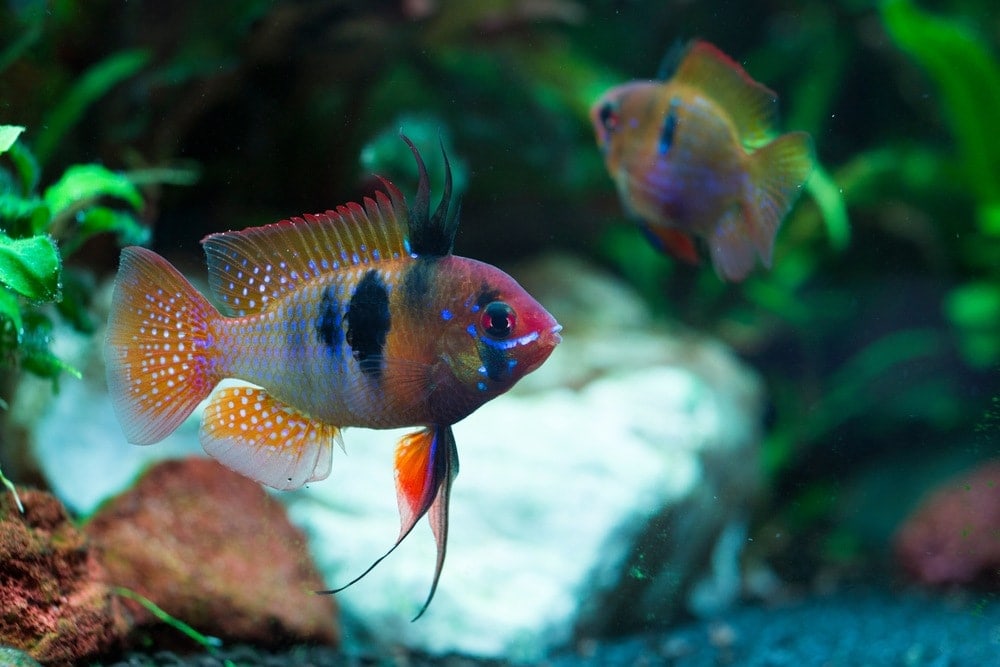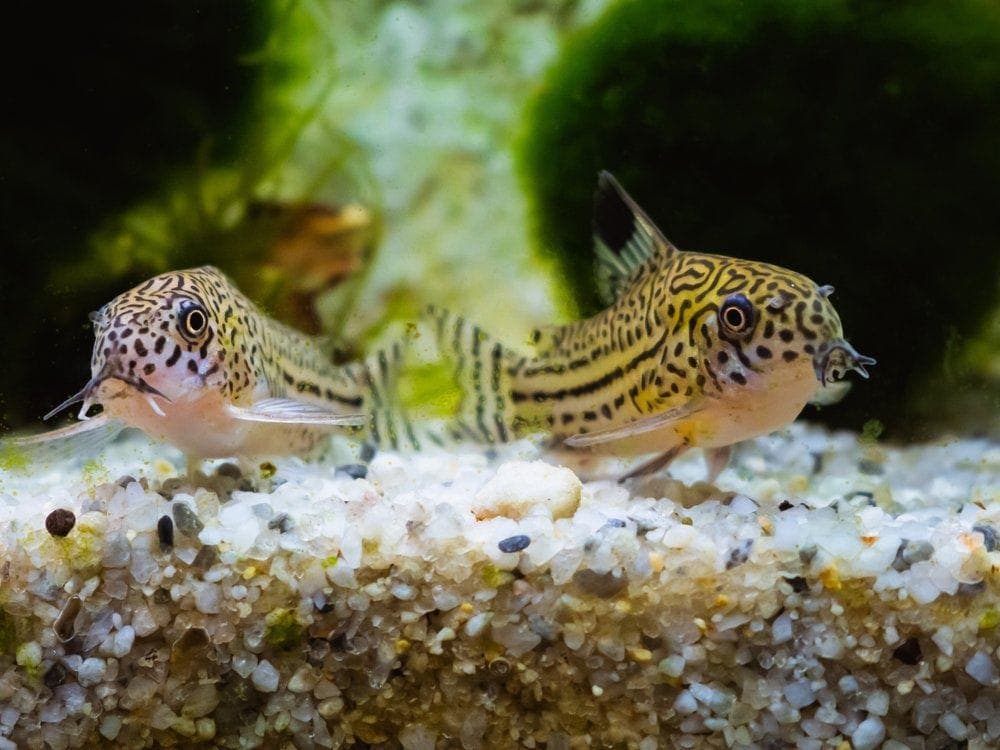Tiger Barb: Care Guide, Varieties, Size & Lifespan (With Pictures)

Updated on
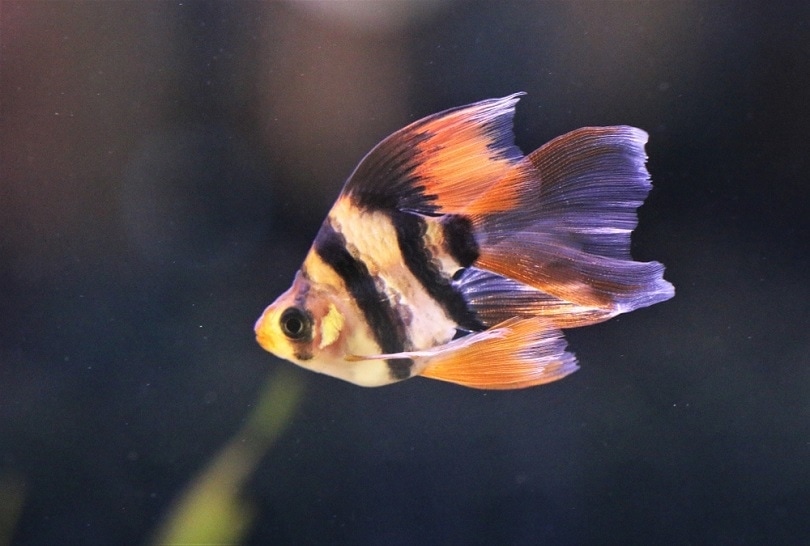
The tiger barb (Puntigrus tetrazona) is a delightful-looking fish with a beloved personality. They have colorful scales that stand out in any aquarium. These fish are also suited for beginners with little experience with tropical species. They are not the friendliest fish when it comes to tank mates and have the potential to fin nip. Their joyous personalities and colorful bodies are commonly seen darting around the aquarium and looking for places to explore.
Tiger barbs make great additions to the right aquarium! Little effort and maintenance are required to keep them happy, and they can thrive in a variety of conditions. This grouping of fish will leave a lasting impression on your tank and readily show off their brilliant colors. This guide will tell you everything you need to know when it comes to caring for your tiger barb.
Quick Facts about Tiger Barbs
| Species Name: | Puntigrus tetrazona |
| Family: | Cyprinidae |
| Care Level: | Beginner to intermediate |
| Temperature: | 73°F to 82°F (23°C to 28°C) |
| Temperament: | Semi-aggressive |
| Color Form: | Silver or gold with black bands and orange tints |
| Lifespan: | 5 to 7 years |
| Size: | 2 to 3 inches |
| Diet: | Omnivore |
| Minimum Tank Size: | 25 gallons |
| Tank Set-Up: | Freshwater: tropical, planted |
| Compatibility: | Difficult |
Tiger Barb Overview
This is a tropical, freshwater species of fish originating from their native waters in Sumatra and Borneo. Tiger barbs are part of the cyprinid fish family. The large amounts of stock available have led to a large natural population in the wild, and populations have spread to the United States and Puerto Rico. Their species-derived name, tetrazona, refers to the four-band pattern that makes them stand out amongst other species of barbs.
These fish can live 5 to 7 years if properly cared for. Tiger barbs are selectively bred and sold to nearly all pet stores that stock fish. They are notoriously known to fin-nip other fish, and this can make them difficult to house them with other species. When kept in large groups with the right tank mates, these fish can successfully be housed in a variety of community aquariums.
They can tolerate a variety of temperatures and conditions, which make them hardy. They are perfect fish for beginners and add a desirable amount of playful personality and brilliant colors to your aquarium. The Malay Peninsula is where their primary natural habitat forms. They can be found at the bottom of swamps and other flowing pools of water. The water is usually shallow, murky, and acidic. Large amounts of decaying plant material like algae cause the water to be quite acidic.
There are a variety of barb species, namely the popular cherry barb or rosy barbs. All of which are attractive and suitable for beginners.
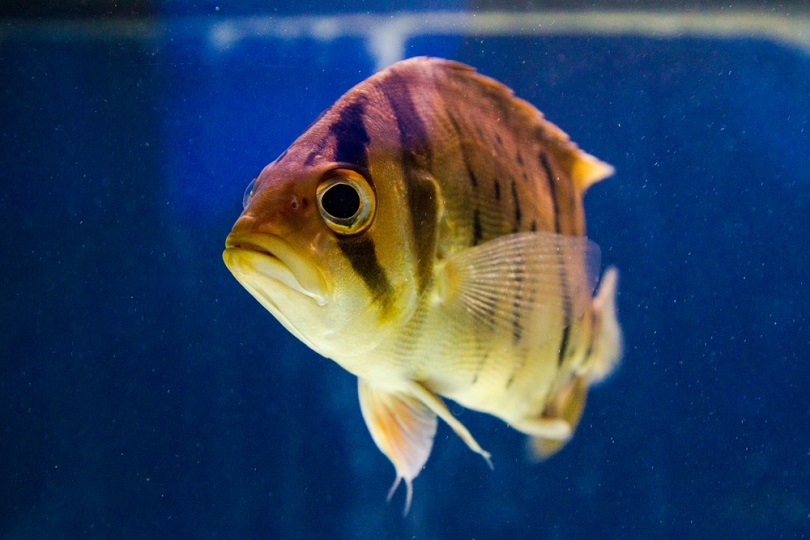
How Much Do Tiger Barbs Cost?
Since tiger barbs are so popular in pet stores and online, you should expect to pay between $2 to $4 for a healthy fish. They are not particularly expensive, and the price varies depending on the type of color and size of the tiger barb. There is a large variety of colors and forms to choose from, and hybridization occurs with this species.
The rare color forms will be more expensive, and an individual fish can cost $6. Since they should be in large groups to form schools, you will need to purchase a minimum of eight for them to successfully shoal. They can be more expensive than other shoaling fish due to their selective breeding and color rarity.
Typical Behavior & Temperament
Tiger barbs have a reputation for being semi-aggressive. They like to establish dominancy in the tank and dominate other vulnerable fish. Tiger barbs are also known to be playful within the aquarium and chase or fin-nip other fish. This behavior can stem down to aggression if their shoal is too small.
Sometimes chasing and fin nipping can occur within the shoal and can become stressful for the fish being exposed to this aggression. When they are kept in large groups, they will typically mind their business and ignore other fish. Some tiger barbs will harass other fish if they feel bored or playful, and enrichment should be added to the tank to buffer this behavior.
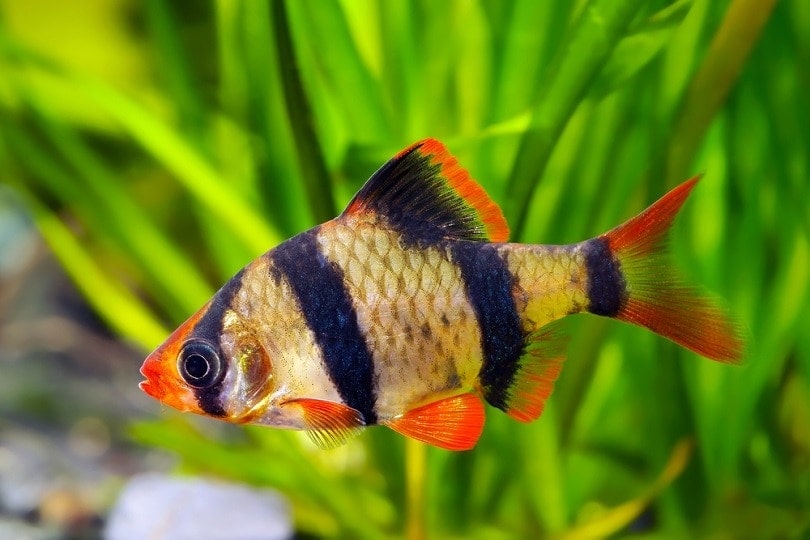
Appearance & Varieties
The average tiger barb grows to a maximum size of 3 inches, but 2.5 inches is a common size in an average aquarium. They are shaped like barbs at the end of spears since they have a triangular mouth shape. Their bodies are flared and wide. The colors present on the fish include an orange and black pattern that gave the species its name.
The females are larger than the males and have rounded bodies. Males are more streamlined, with more vivid colors and patterns. They have four black bands vertically imprinted on their bodies with golden-yellow tinges between each stripe. The scales can also be red, gold, silver, or green. It is not uncommon to see a tiger barb with solid black bands, broken bands, or even very faint bands that can make it appear as if it does not have any bands at all.
The more protein and algae that are added to their diet will cause their colors to become more intense and brighter. Males will be the brightest when they are trying to attract a mate. There is also an albino variant that displays white bands with cream-colored scales. However, it is a rare variety and can mainly be found through online breeders.
How to Take Care of Tiger Barbs
Habitat, Tank Conditions & Setup
Tank/aquarium size
Since tiger barbs should be in shoals, you will need over eight of them to make this achievable. This means they will need a large tank. A general rule of thumb is to keep a group of eight in a minimum of 30 gallons. This gives them room to swim and lower their aggressive behaviors.
A large tank gives them plenty of room to become entertained and less bored. These fish should not be kept in bowls or other spherical and small aquaria. This will cause a variety of issues and cause them to become aggressive toward each other.
Water temperature and pH
They require tropical temperatures with a water temperature between 23°C to 28°C. The water should be acidic, with a range of 6.0 to 7.5 for wild versions. Captive-raised tiger barbs can handle a pH of 8.0.
Substrate
Since their wild habitat consists of a muddy bottom, aquarium sand or fine gravel is recommended as a substrate. This allows for a breeding ground of beneficial bacteria and holds down the roots of plants. This will also give the tank a more natural look while providing them with a substrate they are adapted to living over.
Plants
Tiger barbs are not fussy with the tank decorations, but live plants are appreciated. Live aquarium plants are readily available in their natural habitat, and overgrowth is common. This will also offer them enrichment when they swim between the stems or leaves of the plant. Fake plants can work if you struggle to grow the live variations.
Lighting
The lighting in the aquarium should be mild to moderate. Avoid overly bright artificial or natural lighting. Their natural habitat’s water is murky and usually rich in tannins. Driftwood or Indian almond leaves can release a small number of tannins to replicate this in captivity.
Filtration
Filters are highly recommended for tiger barbs. Their large shoals produce a large amount of waste within the tank. You will therefore need a strong submersible filter to keep the water clean. Live plants can also help with water quality and keep nitrates under control.

Are Tiger Barbs Good Tank Mates?
These fish are not the best tank mates, and pairing them can be difficult. Careful consideration should be taken when housing these fish in community tanks. Since they live with a lot of different fish in the wild, it is easier to get them to co-inhabit with other freshwater species of fish.
You can also keep a few different barbs together since they naturally occur in the wild. Rosy barbs, cherry barbs, and tinfoil barbs are excellent tank mates for tiger barbs. This will also add more color and variety to the tank. They can live peacefully alongside fish that swim at different levels in the tank. Avoid pairing them with fish that have long fins since they will only entice them to fin nip that fish.
- Other barbs
- Mystery snails
- Plecos
- Red-tailed sharks
- Rainbow sharks
- Tetras
- Danios
- Mollies
- Gourami
- Cichlids
- Guppies
- Goldfish
- Betta fish
- Oscars
- Jack Dempsey
What to Feed Your Tiger Barb
These fish are omnivores and feed on plant material, algae, zooplankton, small invertebrates, and worms in the wild. This should be replicated in captivity to ensure they receive all their necessary nutrients and their colors can be intensified. A healthy tiger barb will have bright and shiny scales with a prominent color. Diet is the best way to achieve a healthy tiger barb.
Your aquarium’s water will not have enough zooplankton to provide food for your shoal. You will need to include supplements in the diet. Foods like mosquito larvae, daphnia, bloodworms, and water fleas make excellent protein supplements. Brine shrimp is a top food for tiger barbs, and both adults and fry can eat them. The main diet should include a good commercial pellet for omnivores. You should feed juvenile tiger barbs once a day and the adults twice a day.
Supplements can be given every second day to ensure your fish is getting its necessary dietary requirements.
Keeping Your Tiger Barb Healthy
Tiger barbs are susceptible to ich if their conditions are not right. This disease can be avoided by ensuring they have a heater in the aquarium, a good filter, and a large shoal. You should also do regular water renewals to prevent the water parameters from spiking. Poor water and tank maintenance is the leading cause of unhealthy tiger barbs.
The diet should be high in quality and variety. This is the best way to ensure that the fish is healthy from the inside out. A healthy diet also reduces the risk of disease or infection. Distress is detrimental to the fish and its tank mates.
You should ensure no squabbles occur between the two or even within the group. Erratic activity, lethargy, discoloration, and hiding are signs of an unhealthy and stressed tiger barb. This makes it easy to monitor the health of your fish. The external signs are exceptionally prominent when your tiger barb is feeling either stressed or happy. A healthy tiger barb will have vivid colors and a proportionate body.
Breeding
These fish reach maturity at 6 to 7 weeks of age. They will spawn with multiple mates throughout their lifetime. They spawn in the substrate, which makes it important to choose a good substrate for the bottom of the tank. When you are trying to encourage them to breed, you should feed them a diet rich in protein and increase the amount of food being fed. Feeding them two to three times a day will help condition them to breed.
Brine shrimp and different worms will help to provide them with enough protein to get them to spawn. The temperature should also be increased the week before you want the fish to breed. They should be placed in a breeding tank and removed once the male has fertilized the eggs. They will eat the eggs and fry if they are not removed quickly enough.
Are Tiger Barbs Suitable for Your Aquarium?
If you are looking for an attractive yet playful shoaling fish, the tiger barb may be the right fish for your aquarium! The aquarium should be large with a sandy substrate and dense vegetation. The tank mates should not have long fins or aggressive natures.
The tank should have tropical conditions and not be overcrowded. These fish are also great for watching in an aquarium. Once they are comfortable in their environment, their true colors and personalities will come out and brighten up the tank. We hope this guide has helped to inform you about these desirable shoaling fish.
Featured Image Credit: Arunee Rodloy, Shutterstock





